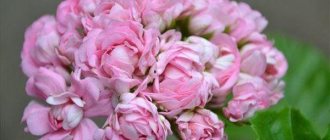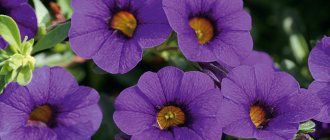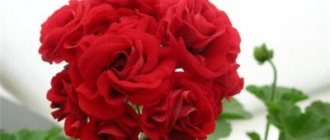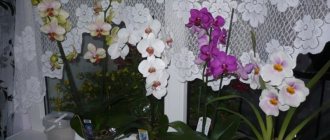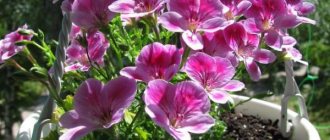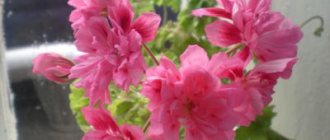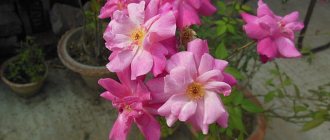A plant native to South Africa conquered the European continent already in the 16th century. Pelargonium or geranium (family Geraniaceae) has long become our favorite indoor and balcony plant.
Pelargonium on the balcony
White pelargonium
It is rapidly spreading throughout the globe, becoming one of the most popular plants. They love geraniums for their decorativeness, unpretentiousness, easy propagation and medicinal properties. And there are so many types and varieties that everyone can choose according to their taste and color.
Pelargonium in a concrete pot
Pelargonium bloom
Features of the classification of pelargoniums
There is no harmonious classification of pelargoniums into groups, species and varieties in the world. There are classifications proposed by different breeders, but none of them can be called perfect. This is due to the fact that in the last century many new varieties were bred: dwarf and variegated forms, with two-color and double flowers.
Pelargonium in home garden decor
Pelargonium in the courtyard of the house
Pelargoniums are most often divided into the following groups:
- Zonal.
- Ivy or balcony.
- Large-flowered (beautifully flowering) or royal.
- Angels.
- Uniques.
Fragrant pelargonium stands out as a separate group, which is not distinguished by beautiful blooms, but has carved leaves. To a greater extent, it can be attributed to decorative leafy forms. But this division is conditional, since fragrant pelargoniums include different species.
Variegated geraniums are also considered as a separate group, but again among these plants there are ivy-leaved and fragrant ones. We will introduce you to the most interesting varieties of this common and unpretentious indoor crop. So, we present varietal pelargoniums.
Geranium
Pelargonium in a pot
Pelargonium in the living room interior
Pelargonium royal: a person of “blue blood”
The most popular is pelargonium, the varieties of which are unique and decorative. The large-flowered plant includes royal pelargonium - one of the brightest and most sophisticated representatives of the species. Beautiful wavy petals and a flower diameter of 4-6 cm distinguish this species from other beautiful flowering forms. This is probably why it is the most capricious and demanding of growing conditions:
- after rooting of cuttings, flowering begins only in the second year;
- does not grow in the open air, in front gardens;
- flowering lasts only 3-4 months;
- in winter it should be at a temperature of +11-13C in bright light, otherwise the plant does not bloom in summer;
- In the spring it needs replanting, increasing the temperature and abundant watering.
Royal pelargonium requires special treatment at home, although most other varieties are not difficult to grow.
Pelargonium in the living room
Pelargonium in country style
Planting a crane bird and caring for the plant
When planting garden geraniums, you should take into account this useful information - when planting a geranium seedling in fertile and moist soil, its root will most likely rot.
The root will have a better chance if it is planted in poor soil, watered infrequently and kept in cool conditions. Garden geraniums need a “cold start”. After this, the plant will not make any special demands and will grow in the garden, to the delight of the gardener.
Garden geranium perennial planting and care - video
Perennial garden geranium needs normal and dosed watering. The plant can remain in a permanent place in the garden for 10 years. It is also not worth specially loosening the soil around the trunk. Only some types of garden geraniums need pruning in the fall, because most of them acquire a beautiful burgundy or yellow color, or even remain winter green.
Garden geranium is often used as an additional plant for perennials. Some types of crane grass go well with roses, rudbeckia, and cornflowers.
Garden geranium is not suitable for growing in greenhouses due to the substance it produces (essential oil).
The plant will respond positively to mineral fertilizers, which should be introduced at the beginning of the growing season and after flowering.
Pelargonium ivy-leaved: ampelous beauty
Drooping, thin, branched stems make it possible to classify this plant as a hanging plant. Pelargonium ivy is distinguished by a fleshy and glossy leaf blade, reminiscent of an ivy leaf in shape. Flowers form umbrella inflorescences of different colors: white, pink or purple. There are unusual varieties with bronze or variegated leaves.
Ampelous pelargonium looks best in flower pots or hanging boxes. The drooping stems end in long pedicels strewn with flowers, including double forms. This beautiful indoor flower grows in flower beds into a continuous carpet of colorful bushes.
Pelargonium in a plaster pot
Geranium in a flowerpot
Pelargonium fragrant: fragrant “Cinderella”
Pelargonium aromatica is distinguished by its aroma and is used to produce geranium oil. If you rub the leaf, the aroma will intensify. The leaf blade is heavily indented, so it does not look like a leaf of indoor geranium. It blooms modestly, and the bushes, growing up to a meter, are not particularly decorative. Although there are attractive varieties, but again due to the leaves, not the flowers.
Can be used as a seasoning for dishes, for the production of drinks and sweets. The species includes about 100 varieties, each of which has a special aroma. And it’s not scary that this species practically does not bloom. The main thing is that it produces a fragrant oil with different aromas.
Pelargonium in the kitchen interior
Fragrant geranium: contraindications
A limitation in the use of any medicines obtained using indoor pelargonium is the presence of a history of diseases such as peptic ulcers and gastritis of various origins. Such drugs and folk remedies are also contraindicated for pregnant women and the elderly. The internal use of infusions and decoctions for the treatment of preschool and primary school children is not recommended. It is important to remember about the limitations caused by individual intolerance and allergic reactions.
Tulip geranium: an indoor miracle
Tulip pelargonium can be proud of its history - there is a secret in its creation. She was bred at Andrea's Nursery (a family nursery in Boston). In 1966 it was presented at the exhibition as a new hybrid. But many consider this species to be simply a mutation, because without proper care it loses its decorative qualities, becoming the same as ordinary domestic pelargonium.
Pelargonium on the loggia
It is interesting for its medium-sized (up to 1 cm) flowers, reminiscent of an unopened tulip. The inflorescence, which can contain up to 50 flowers, looks like a chic bouquet. Differs in shades from delicate to rich, from pink to burgundy. The inside of the flower is more brightly colored. The leaves are interesting because they are tough and shiny. Among these geraniums there are plants from 30 to 70 cm tall.
Pelargonium, the species of which never cease to amaze, remains one of the most beloved indoor plants. In addition to abundant and long-lasting flowering, it has bactericidal properties, purifying room air from ubiquitous microbes.
Botanical description
Pelargonium (lat. Pelargonium) is a plant of the Geraniaceae family. In nature, there are up to 350 species of plants, which are usually herbaceous perennials, but there are also succulent plants and shrubs. Homemade pelargonium is surprising in that it can have a diametrically opposite effect on people: some people feel sick from the scent of Pelargonium, while others it calms and relaxes. Only a few types of Pelargonium have been cultivated, but this does not mean that there is nothing to choose from. In addition to their decorative qualities, Pelargoniums are also useful - they are used in medicine and perfumery. Pelargonium essential oil is used not only as a flavoring agent for soap or perfume, but is also an excellent means of purifying the air from harmful impurities and microorganisms.
Beauty pelargonium: care at home
If you follow simple rules for caring for this crop, it will delight you with its well-groomed appearance and abundant flowering, and its cultivation will become a pleasure.
Pelargonium on the window
Pelargonium at home prefers the following care:
- Watering rules: in summer it likes abundant bathing of the roots, but not spraying. It is especially undesirable to spray the inflorescences. We water every other day, but make sure that moisture does not accumulate in the pan. The rule here is appropriate: it is better to underfill than to overfill. In winter, pelargonium, watering of which is reduced to once a month, rests and gains strength for summer flowering.
- Light rules: for beautiful and long flowering, for the stems to be thick and the leaves to be juicy, you need a lot of light. If the geranium is located on a south window, then it is advisable to shade it a little from the direct rays of the sun. In winter, you can add artificial lighting. It will not bloom in a shaded place; the stems will stretch and the leaves will fade.
- Comfortable temperature: During growth and flowering, indoor crops need warmth. She feels good at t= +20-25C. From October to February there is a period of rest and during this period the optimum temperature is +12-15C.
- Air humidity mode: the air in the apartment should be moderately humid. Indoor pelargonium loves fresh air, access to which must be provided to it.
- Nutrition rules: geraniums need to be fed during the period of active growth - from spring to autumn. Feeding is carried out 2 times a month. Like any other crop, pelargonium needs nitrogen for abundant lush foliage, potassium and phosphorus for long and bright flowering. Fertilizers should be applied in liquid form to slightly moistened soil. There is a special fertilizer for pelargonium - Pelargovit, which is used according to the instructions.
You can use various organic substances: wood ash, infusion of bird droppings or herbs, humus. Therefore, the question of how to feed geranium is not particularly pressing. The main thing is to dilute fertilizers in the right proportion.
Now it’s clear how to care for pelargonium. The question remains how to properly propagate and plant it.
Pelargonium in a wicker pot
Briefly about cultivation
- Flowering: from May to October.
- Lighting: bright sunlight.
- Temperature: in spring and summer – 25-30 ºC, in winter – no higher than 14 ºC.
- Watering: in spring and summer - 3-4 days after the top layer of soil in the pot dries. In winter - when the earthen ball dries to a third of its depth.
- Humidity: normal for residential premises.
- Feeding: in spring and summer - once every two weeks with mineral fertilizer for flowering plants. After flowering is completed, feeding is stopped.
- Dormant period: from November to March.
- Pruning: annually during the period until early March.
- Replanting: young plants - annually, and adults - when the roots completely entwine the earthen ball.
- Substrate: humus, leaf, turf soil and sand in equal parts.
- Reproduction: seeds and cuttings.
- Pests: whiteflies and aphids.
- Diseases: root rot, gray rot, loss of attractiveness of leaves due to improper maintenance conditions.
- Properties: some types of pelargonium are poisonous!
Read more about growing pelargonium below.
Basic secrets of reproduction
There are no special secrets here, but there are three main methods of reproduction.
Cuttings
The simplest and most accessible method is cuttings. Cuttings can be cut in March-February or July-August. The cut stalk should be 5-7 cm in size with 2-3 leaves.
It is withered a little (allowed to dry, but not dry out) and planted in the substrate. Abundant watering is needed, but should not be covered. After about a month, the cuttings will take root and can be planted in a separate container.
You can simply put the shoot in water and get a small plant with a root system. If you are worried that your pet will not grow roots, add growth stimulants to the water, for example, Kornevin.
Pelargonium in a hanging pot
Seeds
Pelargonium grows from seeds at home. They begin to germinate in February-March, laying them out on moist soil and lightly sprinkling them with soil. We maintain room temperature, cover the container with film, and periodically moisten the soil.
Shoots appear quickly, after about 2 weeks. They are dived and placed in a cooler room with good lighting. Then you can plant the pelargonium in a pot, placing it in the light.
It blooms in the first year after planting, but even a small plant does not bloom in the shade.
Pelargonium in Provence style
Dividing the bush
How to propagate pelargonium by dividing the bush? When the pot for the plant becomes cramped, you can divide the geranium into 2-3 parts, planting each in a separate container. Geranium takes root quite easily, so problems should not arise with this method of propagation.
Pink pelargonium
Pelargonium in the garden
Diseases and pests
Fragrant geranium resists diseases , but they arise due to improper care: high humidity, low acidity of the soil lead to the development of fungal infections. Excessive watering is fraught with the development of stem, root and gray rot.
Fighting methods:
- Root rot - makes the roots soft, and the stem - affects the petioles, as a result of which they become black and weeping. Gray rot can be recognized by plaque on the leaves and peduncles. The following drugs are used for treatment:
- Fundazol;
Fitosporin-M;
- Topaz;
- Gamair;
- Baktofit.
Ticks . They can appear at high air temperatures. Insects live on the inside of the leaf, make punctures there and suck out the juice. As a result, the leaves become spotted and curled. As soon as parasites have been detected, it is necessary to treat the plant with soap, wait 2-3 hours and rinse with water. In case of severe damage, chemicals are used:- Karbofos;
- Karate Zeon;
- Fitoverm;
- Anti-mite.
- Thrips and whiteflies. Sticky traps help get rid of them. Affected plants are treated with the following insecticides:
- Aktara;
- Aktellik;
- Confidor.
In cuttings, black rot cannot be treated. The infected flower must be thrown away and the soil sterilized.
How to plant a plant correctly?
Planting pelargonium is traditional, as for most indoor crops:
- The flower pot should match the size of the plant.
- There are drainage holes at the bottom to allow excess moisture to drain into the pan.
- If you plan to rearrange the plant, it is better to use a plastic container for planting.
- Select the soil: it should be loose, dry well and contain organic matter. It is better to use good quality purchased soil.
- Pour the soil mixture into the pot, making a hole in the middle for the roots.
- Pour water into the hole, place the roots of the plant and cover with soil.
- Place the plant planted in this way in the designated place.
- If the geranium does not bloom for a long time, find a lighter area in the apartment for it.
If the pot for planting the crop is not new, then it must be thoroughly washed and disinfected with a solution of potassium permanganate. Such a pot can harbor bacteria that can infect the plant planted in it.
Pelargonium Tuscany
Garden pelargonium
The pelargonium flower is a unique ornamental and medicinal plant. It will bring bright, rich colors into the house and rid the air of pathogenic bacteria. It will make your home cozy and green, without demanding special treatment in return. This is probably why beautiful geraniums peek out from many windows in houses.
Pelargonium zonal

